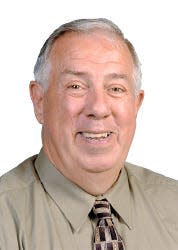'Oppenheimer' shows the perils of nuclear weapons and the future we still face
- Oops!Something went wrong.Please try again later.
Last Saturday, I ventured to the movies.
I hadn’t been to the movies for some time, the popcorn seemed inviting, and the movie "Oppenheimer" was playing.
Many years ago, while in school, I did a research paper on J. Robert Oppenheimer (1904-1967) who was a renown physicist during World War II.

As you may remember, Adolf Hitler and Japanese Emperor Hirohito were serving chaos and death around the globe. The world was a most dangerous place.
America and its allies were under great distress.
Military intelligence back then had suggested that Hitler’s minions and scientists were working on a "gigantic bomb" to sway victory into their corner.
President Franklin D. Roosevelt would task a young physicist, Oppenheimer, to develop America’s first nuclear bomb in response.
This was back in the day when Albert Einstein roamed the scientific field and had open conversations with Oppenheimer about his work.
The movie is a fascinating story of this physicist’s life and his team’s task to create a powerful bomb before the Germans.
He would call this assignment the "Manhattan Project," and our government would actually build a small city in the desert at Los Alamos, New Mexico, to conduct the necessary laboratory tests.
Several thousand people would live there, and the most renowned scientists in the country were gathered for research into the building of a massive bomb that would end the war and thwart Hitler and Hirohito’s ambitions to conquer the world.
As the suspense of the story unfolds, Oppenheimer would come under some suspicion, too, since he once had a lady friend and other acquaintances who had communist ties.
This created a concern for government officials.
As Oppenheimer and his team worked diligently on their assignment, his leadership and scientific expertise were instrumental in the project’s success.
On July 16, 1945, after many strenuous hours of work, Oppenheimer and his team conducted the first test of an atomic bomb on American soil.
"Trinity" was the project name for this test of the most massive bomb ever created by man at the time.
On Aug. 6 of the same year, Hiroshima and Nagasaki would become the only cities ever attacked by nuclear weapons during a war.
The Campaign for Nuclear Disarmament reported that "the results of the bomb dropped over Hiroshima was equal to 15,000 tons of TNT; it razed and burnt around 70 per cent of all buildings and caused an estimated 140,000 deaths by the end of 1945, along with increased rates of cancer and chronic disease among the survivors."
In Nagasaki, "a slightly larger plutonium bomb was exploded and three days later leveled 6.7 square kilometers of the city and killed 74,000 people by the end of 1945.
In Hiroshima, 90% of physicians and nurses were killed or injured, and 42 of 45 hospitals were rendered non-functional. There was little to no aid to assist the injured and dying.
Oppenheimer’s research and experiments in project Trinity had successfully achieved its goal. The Japanese would surrender less than a month later, officially ending the war. But the nuclear arms race began its march down a slippery slope of diplomacy, which still exists.
Today, J. Robert Oppenheimer is considered the father of the atomic bomb.
In the aftermath of the bombings of Hiroshima and Nagasaki, Oppenheimer who had read and studied the ancient Hindu text of the Bhagavad Gita, is believed to have borrowed a line from this text to describe his role:
"Now I become Death, the destroyer of worlds …"
He knew and fully understood the ramifications of his deadly creation and its impact on the world’s future.
Despite his misplaced satisfaction with his wartime service and achievement, he also became vocal about the need to contain this dangerous technology.
But we all know how difficult it is for someone to keep a secret, huh?
Several countries now have this same technology while others still seek it.
Oppenheimer lived out his life in the Virgin Islands in seclusion. He believed this location would be a safe haven from any nuclear attack.
According to Samantha Franco in an August article for War History Online, when Oppenheimer died in 1967, he was not buried.
He was instead cremated and his ashes were spread near Carvel Rock in the Virgin Islands.
An irony of sorts, I’m thinking, since many Japanese victims took that same path to the afterlife, howbeit, their ashes were spread under that debris of an atomic bomb.
Our future awaits us.
Pete Waters is a Sharpsburg resident who writes for The Herald-Mail.
This article originally appeared on The Herald-Mail: Film depicts father of atomic bomb and his fears for the future
